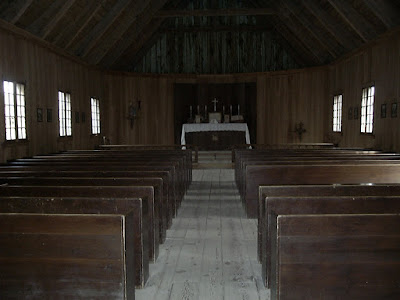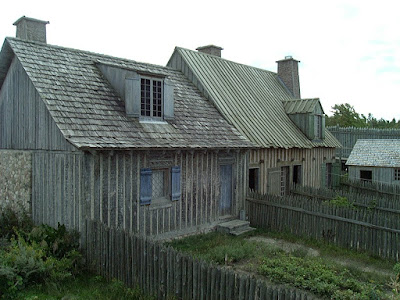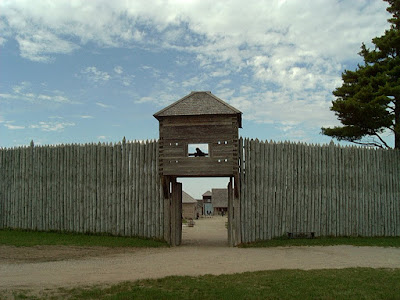The fort was more than a military outpost; it was a trading post and fortified village as well, containing storehouses and civilian dwellings. Surrendered to the British at the end of the French and Indian War in 1761 it was captured during Pontiac's Rebellion in 1763 and held by the Ojibwa Indians for a year until the British negotiated its return. The British decided that the position was too exposed and moved the fort and the town across the Straits to Mackinac Island but (confusingly) kept the name of the fort Michilimackinac, after establishing the position on Mackinac Island they burned the remains of the original fort.
the fort as seen by Google Earth
the fort as seen by a visitor approaching on the beach from the east
a slightly closer view
the fort blends in with the surroundings,
if it wasn't for its unique location it would be easy to miss from the water
despite it being August the day was windy and chilly
looking west from the front of the fort
the beaches are shallow and sandy
the north east corner of the fort
I hesitate to call it a bastion, more like a tower or sentry post
looking south along the eastern wall
a closer look at the northeastern tower
the northern gate
looking west along the northern face from the northern gate
a closer look at the northern gate
the Commanding Officer's House
the northern gate from the inside
the inside of the northern wall looking east from the northern gate
just west of the main north-south roadway is the King's Storehouse (left)
and the Guardroom with its unusual arched porch
the King's Storehouse is an unimaginative, but functional, structure
looking west along the pathway just south of the storehouse
the hearths are massive stone affairs, they hold the heat of
the fire and act as a passive heater once the fire has burned out
uniformed staff explaining the niceties of musketry drill to visitors
looking west along the interior of the north wall
just to the west of the main north-south street
looking south from the same position;
long barracks to the left, guardroom to the right
another view of the Commanding Officer's house
a neat "child-interactive" sign
interior of the guardroom
the Parks Service has gone to considerable lengths to make the mannequins realistic
the row of trader's shops/residences
interior shots of the same
the upstairs of a trader's house, I think that I would want
more supplies if I was looking at spending a winter in the north of Michigan
a view to the north from that upstairs window;
guardroom the left, long barracks to the right
interior of the Church of Saint Anne
the priest's quarters
the clergy did rather well back in the day
the blacksmith's forge
more domestic housing, there is an interesting underground passage between two
of the buildings that showcases the archaeology that has taken place here at the fort
the priest got his own home, it was attached to the church
another look at the guardroom
the front porch is unlike any other building of the period that I have seen
inside the long barracks
more massive fireplaces
glass for windows must have been incredibly expensive this far into the interior
but was crucial given the harsh winters
inside the Commanding Officer's house

spartan, to say the least
trade goods, European cloth and metal goods were the basis of trade
the northwest tower from the center of town
one of the displays cataloged the series of forts that were built at the Straits
did I ever mention that I love models like this?
and the accompanying information placard,
the artwork was particularly well done
the combined role of the position as a trading post/village/fort
is demonstrated by the houses packed into the narrow confines of the walls
I really like the models
maybe I will one for myself , except that it would
be on par with the Castillo model for size (and storage)
the Piquet House
the vertical log construction of the homes was a French technique
clay-packed wattle was a poor-man's chimney
interior of the Piquet House
the latrines, no privacy here!
outside of the latrines
a lot of cooking was done outside during good weather
gardens provided the Europeans with familiar vegetables
looking southwest from the center of town
looking south from the same
looking dead south from the center of town
panning to the east
looking southeast
and straight east from the center of town
across the Parade Ground toward the northeast
the northeast tower
looking north toward the Commanding Officer's house and the north gate
straight north; long barracks on the left, Commanding Officer's house to the right
not a lot of frills when it comes to the barracks building
continuing to turn counter-clockwise, the back of the church
the Chevalier House
apparently experiencing some structural issues
these structures also contain another underground passage that interprets the excavation
of the powder magazine and the weapons that were used at the fort
a wall gun, it is almost seven feet long and has a bore over an inch
French and British muskets
the southeast tower
small cannon were mounted in the tiny bastions that supported the corner towers
the view outward, keeping the brush cut back away from the fort must have been a constant task
a view from the cannon port looking north along the exterior of the east wall
looking south along the interior of the east wall from the northeast tower
the trader's quarters from the top of the south gate,
the grassy area in the foreground would have been occupied by additional housing
looking straight north from the top of the south gate
looking to the northeast from the top of the south gate
looking east along the interior of the south wall from the south gate
the powder magazine was buried underground and closed with a heavy wooden door
of course, it was kept locked
looking south along the exterior of the east wall from the northeast tower
construction details (I doubt that the French had use of modern steel bolts, upper left)
wooden pegs stood in for nails
the view west along the outside of the south wall from the musket port in the southeast tower
there was a considerable amount of housing and farming in the area of the fort
looking north along the east wall
the interior from the wall walk
the long barracks viewed across the Parade Ground from the wall walk on the eastern wall
the entry to a tower, most likely there was a ladder here instead of a stairway
looking west from the northeast tower
and north
and to the east we find the Mackinac Bridge
south along the eastern wall from the northeast tower
the Parade Ground from the northeast tower
looking west along the north wall from the northeast tower
musket port at wall walk level (about ten feet above ground level)
simple but effective
domestic gardens
looking east along the north wall from the north gate
looking southeast from the northwest tower
space was at a premium and there were no cars, lanes could be narrow
looking east from the center of the west wall walk
more domestic gardens
the area that was under investigation by archaeologists when I visited
interior gate details
looking west from just outside the south gate
looking east from just outside the south gate
looking north at the south gate
a closer view of the same
a typical French habitant's house
farming must have been difficult given the short summer and poor soil
the east wall and northeast tower
a surprising amount of daylight gets through the palisade
the south gate
southeastern tower and east wall looking north into the Straits
the eastern wall, notice the cloud cover, this photo was taken minutes after the previous one,
the weather can turn suddenly due to the local geography
a native wigwam, they probably didn't have access to plastic tarps back in the day
an "art-shot" the northeast tower through the trees
The fort is the site of the longest-running archeological excavations in the State of Michigan, having been under continuous study since 1959. Completion of the digging is normally followed by a reconstruction of the building that had been investigated.
Located on the northernmost tip of Michigan's Lower Peninsula it is just west of the mighty Mackinaw Bridge. The Historical Society runs a very impressive gift shop and publishes the findings of the excavations as they are reported yearly. A surprising number of diaries and records have survived the centuries and are also available as reprints. A look at their published materials is well worth the time. Another way to spend some time on the internet is to look at the Mackinac State Historic Parks website (in truth it is worth going to just for the drone overflights of the forts). But, nothing matches a visit, if you are anywhere near the Straits take a day or two and visit all three of the forts.














































































































































Great post. I haven't been there since Marsha and I first got married...
ReplyDelete